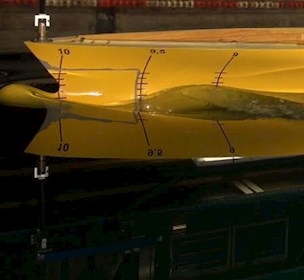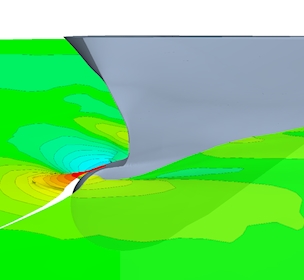Ship propulsion optimisation
With today’s financial markets, shipowners are focusing on optimising the performance of their existing fleet instead of ordering new ships.
- When optimising existing ships, there are two main approaches: Keep speed constant and optimise the hull and propulsion system
- Reduce speed and optimise the hull and propulsion system to the new speed.
Through the years, we have worked closely together with engine providers and sub-suppliers in order to achieve the best results.
Reduction of speed
Speed reduction is a highly effective way to reduce fuel consumption and emission. When reducing speed, the rule assumes that the power scales with third power of speed. Thus, a 10% speed reduction leads to about 27% (0.93=0.73) power saving. But slow steaming, as it is popularly named, does come with a capacity cost, capital costs, crew costs and safety:- Slower speed means reduced transport capacity. Reducing speed by 10% would require 10% more ship capacity to keep transport capacity constant. However, revenues and required ship capacity scale with speed, while fuel saving scales with speed to the third power or more.
- Capital costs of cargo depend on transport time and cargo value. Slower transport increases the capital costs on the cargo.
- Crew costs are independent of speed. However, slow ships transport less. So for the same transport capacity, more ships are needed, hence crew costs increase.
- For safety reasons, speed should not be too low. For a ship to maneuver safely against strong winds and seaways, her speed must not be reduced below her steerage capabilities.
Main engine upgrade/tuning
When reducing speed, the main engine should be generally updated and/or tuned to match the lower speed steaming of the ship. Sea margins should be adapted to ship size and type and carefully considered (estimated) based on the prevailing ship routes and associated environmental conditions - for some routes it may be possible to use a route-based sea margin, for some this might not be relevant. A study performed by FORCE Technology on the Grontmij designed Seahorse 35 showed that an engine optimised for slow steaming meant that the required engine power at 14 knots was reduced by 3%.Propeller redesign
When slow steaming and/or upgrading the main engine, a redesigned propeller can provide further gains. Basic propeller theory clearly indicates an advantage (in terms of propeller efficiency) of slow-rotating, highdiameter propellers. Hence, in the pursuit of reduced fuel consumption, re-design of the propeller towards lower RPM/larger propeller diameter most often leads to effective power savings. In addition to the diameter optimisation, several vendors are offering new and improved propeller designs for existing vessels providing savings from 3-7% depending on whether speed is kept constant or is reduced.At constant speed
When keeping the speed constant, a set of tools is available for optimisation purposes. These are, of course, also usable when optimising at reduced speed.Energy Saving Devices (ESD)
For both approaches, it is possible to fit the vessel with ESD’s. Below are some of the reasons for poor performance and suggestions on how to use ESD to optimise the propulsive efficiency:
- Wake equalizing Dducts and vortex generators: Address in-homogeneous inflow to the propeller.
- Pre-swirl fin systems and contra-rotating propellers: Reduce rotational losses.
- Twisted rudder: Improves hull-propeller interaction.
- Propeller boss cap fins (PBCF) and rudder bulbs: Minimise hub vortex losses.
A typical example of combined energy-saving effect is the recent Becker Mewis Duct® concept which combines the wake-equalising/ thrust-producing effect of the duct in front of the propeller with the reduced rotational losses of the pre-swirl fin system.
Optimised hull form
A more drastic approach can be to change the hull form. In these projects, the shipowners typically replace the bulb or even a greater part of the fore-ship. In a recent project for Clipper, FORCE Technology carried out a comprehensive optimisation study on Clipper’s G-class using FRIENDSHIP Frame work/RANS CFD. The study showed a saving of up to 7.5% for a specific condition and a saving on the operational profile of about 4% giving an ROI of less than 2 years.




